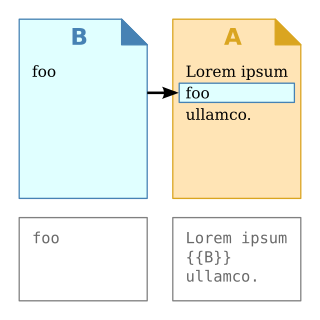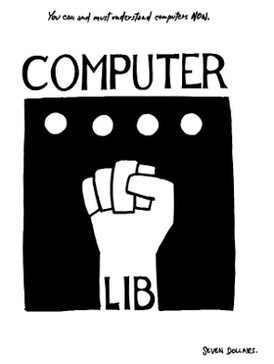Related Research Articles

Hypertext is text displayed on a computer display or other electronic devices with references (hyperlinks) to other text that the reader can immediately access. Hypertext documents are interconnected by hyperlinks, which are typically activated by a mouse click, keypress set, or screen touch. Apart from text, the term "hypertext" is also sometimes used to describe tables, images, and other presentational content formats with integrated hyperlinks. Hypertext is one of the key underlying concepts of the World Wide Web, where Web pages are often written in the Hypertext Markup Language (HTML). As implemented on the Web, hypertext enables the easy-to-use publication of information over the Internet.

In computer science, transclusion is the inclusion of part or all of an electronic document into one or more other documents by reference via hypertext. Transclusion is usually performed when the referencing document is displayed, and is normally automatic and transparent to the end user. The result of transclusion is a single integrated document made of parts assembled dynamically from separate sources, possibly stored on different computers in disparate places.

Theodor Holm Nelson is an American pioneer of information technology, philosopher, and sociologist. He coined the terms hypertext and hypermedia in 1963 and published them in 1965. According to a 1997 Forbes profile, Nelson "sees himself as a literary romantic, like a Cyrano de Bergerac, or 'the Orson Welles of software'."
Project Xanadu was the first hypertext project, founded in 1960 by Ted Nelson. Administrators of Project Xanadu have declared it superior to the World Wide Web, with the mission statement: "Today's popular software simulates paper. The World Wide Web trivialises our original hypertext model with one-way ever-breaking links and no management of version or contents."
This article presents a timeline of hypertext technology, including "hypermedia" and related human–computer interaction projects and developments from 1945 on. The term hypertext is credited to the author and philosopher Ted Nelson.
Hypertext fiction is a genre of electronic literature, characterized by the use of hypertext links that provide a new context for non-linearity in literature and reader interaction. The reader typically chooses links to move from one node of text to the next, and in this fashion arranges a story from a deeper pool of potential stories. Its spirit can also be seen in interactive fiction.
Cory Arcangel is an American post-conceptual artist who makes work in many different media, including drawing, music, video, performance art, and video game modifications, for which he is best known.
Electronic literature or digital literature is a genre of literature where digital capabilities such as interactivity, multimodality or algorithmic text generation are used aesthetically. Works of electronic literature are usually intended to be read on digital devices, such as computers, tablets, and mobile phones. They cannot be easily printed, or cannot be printed at all, because elements crucial to the work cannot be carried over onto a printed version.

ZigZag is a data model, invented by Ted Nelson, that deconstructs the spreadsheet to allow irregular relations, at the same time generalizing the idea to multiple dimensions.

The Mundaneum was an institution which aimed to gather together all the world's knowledge and classify it according to a system called the Universal Decimal Classification. It was developed at the turn of the 20th century by Belgian lawyers Paul Otlet and Henri La Fontaine. The Mundaneum has been identified as a milestone in the history of data collection and management, and as a precursor to the Internet.

Computer Lib/Dream Machines is a 1974 book by Ted Nelson, printed as a two-front-cover paperback to indicate its "intertwingled" nature. Originally self-published by Nelson, it was republished with a foreword by Stewart Brand in 1987 by Microsoft Press.
Hyperland is a 50-minute-long documentary film about hypertext and surrounding technologies. It was written by Douglas Adams and produced and directed by Max Whitby for BBC Two in 1990. It stars Douglas Adams as a computer user and Tom Baker, with whom Adams had already worked on Doctor Who, as a personification of a software agent.

Interactive design is a user-oriented field of study that focuses on meaningful communication using media to create products through cyclical and collaborative processes between people and technology. Successful interactive designs have simple, clearly defined goals, a strong purpose and intuitive screen interface.
Enfilades are a class of tree data structures invented by computer scientist Ted Nelson and used in Project Xanadu "Green" designs of the 1970s and 1980s. Enfilades allow quick editing, versioning, retrieval and inter-comparison operations in a large, cross-linked hypertext database. The Xanadu "Gold" design starting in the 1990s used a related data structure called the Ent.

Hypertext is text displayed on a computer or other electronic device with references (hyperlinks) to other text that the reader can immediately access, usually by a mouse click or keypress sequence. Early conceptions of hypertext defined it as text that could be connected by a linking system to a range of other documents that were stored outside that text. In 1934 Belgian bibliographer, Paul Otlet, developed a blueprint for links that telescoped out from hypertext electrically to allow readers to access documents, books, photographs, and so on, stored anywhere in the world.
Microcosm was a hypermedia system, originally developed in 1988 by the Department of Electronics and Computer Science at the University of Southampton, with a small team of researchers in the Computer Science group: Wendy Hall, Andrew Fountain, Hugh Davis and Ian Heath. The system pre-dates the web and builds on early hypermedia systems, such as Ted Nelson's Project Xanadu and work of Douglas Engelbart. And like Intermedia or Hyper-G, which were other hypermedia systems created around the same time, Microcosm stores links between documents in a separate database.

Porpentine Charity Heartscape is a video game designer, new media artist, writer and curator based in Oakland, California. She is primarily a developer of hypertext games and interactive fiction mainly built using Twine. She has been awarded a Creative Capital grant, a Rhizome.org commission, the Prix Net Art, and a Sundance Institute's New Frontier Story Lab Fellowship. Her work was included in the 2017 Whitney Biennial. She was an editor for freeindiegam.es, a curated collection of free, independently produced games. She was a columnist for online PC gaming magazine Rock, Paper, Shotgun.

Simone Leigh is an American artist from Chicago who works in New York City in the United States. She works in various media including sculpture, installations, video, performance, and social practice. Leigh has described her work as auto-ethnographic, and her interests include African art and vernacular objects, performance, and feminism. Her work is concerned with the marginalization of women of color and reframes their experience as central to society. Leigh has often said that her work is focused on “Black female subjectivity,” with an interest in complex interplays between various strands of history. She was named one of the 100 most influential people in the world by Time magazine in 2023.

LaToya Ruby Frazier is an American artist and professor of photography at the School of the Art Institute of Chicago.
K-HOLE was a trend forecasting artist collective founded by Greg Fong, Sean Monahan, Chris Sherron, Emily Segal, and Dena Yago. The group operated between 2011 and 2016 and was based in New York City.
References
- ↑ Taylor-Foster, James (2017-03-27). "'Are.na' is an Online Tool for Contextualizing the Internet - Here's Why It's Useful to Architects". ArchDaily . Retrieved December 1, 2017.
- ↑ Broskoski, Charles. "How do You Describe Are.Na at a Party?".
- ↑ "Consumer Reports: Cory Arcangel". ARTnews . 2015-09-18. Retrieved December 1, 2017.
- ↑ "Can You Teach Good Design on a Social Media Network?". Metropolis. Retrieved 2022-05-31.
- ↑ "Allan Yu". The Caret. Retrieved December 1, 2017.
- ↑ "Nemesis Global" . Retrieved June 14, 2018.
- ↑ "Creatives Are Flocking to this Artist-Designed Social Network". Artsy. Retrieved February 19, 2018.
- ↑ "Consumer Reports: Michael Bell-Smith". ARTnews . 2015-08-06. Retrieved December 1, 2017.
- 1 2 Schwulst, Laurel (2017-10-25). "Charles Broskoski on self-discovery that happens upon revisiting things you've accumulated over time". The Creative Independent. Retrieved February 28, 2024.
- ↑ Schwab, Katharine (2018-01-18). "This Is What A Designer-Led Social Network Looks Like". Co.Design. Retrieved February 19, 2018.
- ↑ "Counter Currents: Are.na on Ted Nelson's Computer Lib/Dream Machines". 2016-01-19. Retrieved December 1, 2017.
- ↑ "The Guggenheim's first online exhibit lets you invest in the future". Mashable. 2015-11-04. Retrieved December 1, 2017.
- ↑ "Chicago Architecture Biennial". Are.na. Retrieved December 1, 2017.
- ↑ "Introducing the Chicago Architecture Biennial blog". 2017-06-06. Retrieved December 1, 2017.
- ↑ Tan, Alicia Marie. "Incongruous: Are.na". Museum of Arts and Design . Retrieved December 1, 2017.